| |

Terminator
2: 3-D
Call
it a "show;" call it a "dark ride." Whatever
you call it, T2:3-D is still one of the greatest attractions
ever created.
Universal
first came to the big Orlando theme park party in 1990 with Universal
Studios Florida, a more elaborate version of the "backlot
tour" park the company operates in Hollywood, California.
Filled with one-of-a-kind rides based on blockbuster movies like King Kong, Earthquake and Jaws, USF was an ambitious
attempt to out-Disney Disney. Early months were marred by technical
difficulties, but those problems were ultimately surmounted and
The Studios quickly became Orlando's second most-popular draw.
What put USF
truly on the map was a multi-million dollar marvel that did indeed
give the Disney folks a run for their money: Back To The Future:
The Ride. This amazing motion-simulator attraction begins
with a lengthy pre-show starring two of the BTTF trilogy's characters,
Doctor Emmett Brown and Biff Tanen (hilariously played by Christopher
Lloyd and Thomas F. Wilson). We discover that Biff, petty thug
to the core, has stolen one of the Doctor's levitating, time-traveling
De Loreans and we must board our own to chase him down and bring
him back. During the course of our madcap pursuit, we crash through
a futuristic city, into the gullet of a raging dinosaur and over
the edge of a prehistoric lava-fall before making it back to the
Doctor's lab - four incredible minutes of rip-roaring action.
With the De
Lorean's swoops, dives and lurches mated to special effects-crammed
film sequences projected on a huge overhead dome, the illusion
is nearly seemless. Upon its debut, Back To The Future: The Ride
brought the simulator ride to a whole new level and for years,
it reigned as the premier attraction behind Universal Studios
Florida's gates. But that reign ended in 1996, when the park opened
its Terminator 2:3-D "virtual adventure."
.
. . . . . . . . . . . . . . . . . . . . . . .
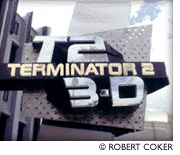 Terminator
2:3-D - Battle Across Time is a supercharged third chapter
in the Terminator saga created by writer/director James Cameron.
Starring Arnold Schwarzenegger and Linda Hamilton, the first Terminator flick introduced us to a flesh-covered "T-800" robot
sent back in time from a nuclear holocaust-devastated future where
sentient machines rule over mankind. The cyborg's mission? To
"terminate" Sarah Connor and preemptively destroy the
son she hasn't yet conceived. As poor Sarah eventually learns,
her unborn son John would become the leader of a human resistance
movement against the machines. She barely survives, but before
the end credits roll, the first Terminator is smashed beyond repair.
And Sarah is pregnant. Terminator
2:3-D - Battle Across Time is a supercharged third chapter
in the Terminator saga created by writer/director James Cameron.
Starring Arnold Schwarzenegger and Linda Hamilton, the first Terminator flick introduced us to a flesh-covered "T-800" robot
sent back in time from a nuclear holocaust-devastated future where
sentient machines rule over mankind. The cyborg's mission? To
"terminate" Sarah Connor and preemptively destroy the
son she hasn't yet conceived. As poor Sarah eventually learns,
her unborn son John would become the leader of a human resistance
movement against the machines. She barely survives, but before
the end credits roll, the first Terminator is smashed beyond repair.
And Sarah is pregnant.
In the eye-popping
sequel, Terminator 2; Judgment Day, a far more deadly "liquid
metal" T-1000 is sent back to kill John, now an adolescent.
Sarah, John and a reprogrammed older-model Terminator sent to
protect the boy do spectacular battle with this relentless, morphing
creature and the T-1000 is ultimately melted in a vat of boiling
metal. Yes, the film ends on an upbeat note but the story isn't
really over...
.
. . . . . . . . . . . . . . . . . . . . . . .
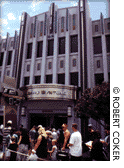 After
the sequel raked in more than $500 million worldwide, Universal
Studios purchased the rights to create a theme park attraction
based on the Terminator series. The company then hired Landmark
Entertainment Group (creators of Star
Trek: The Experience), to develop a stunt show that would
put guests right in the middle of a Terminator battle royale.
Led by Landmark CEO Gary Goddard, a creative team began storyboarding
ideas. It soon became clear that a show limited to live performances
could never capture the explosive intensity of the two motion
pictures, so Goddard and his designers instead proposed that three-dimensional
film sequences be incorporated into the final product. Universal
agreed and the Landmark crew went back to work. After
the sequel raked in more than $500 million worldwide, Universal
Studios purchased the rights to create a theme park attraction
based on the Terminator series. The company then hired Landmark
Entertainment Group (creators of Star
Trek: The Experience), to develop a stunt show that would
put guests right in the middle of a Terminator battle royale.
Led by Landmark CEO Gary Goddard, a creative team began storyboarding
ideas. It soon became clear that a show limited to live performances
could never capture the explosive intensity of the two motion
pictures, so Goddard and his designers instead proposed that three-dimensional
film sequences be incorporated into the final product. Universal
agreed and the Landmark crew went back to work.
When the reconceived
storyboards were presented for approvals to James Cameron, he
was so excited by the project that he chose to helm the creation
of the filmed sequences, bringing along his Digital Domain special
effects corps and convincing the feature films' original cast
(including Edward Furlong and Robert Patrick) to participate.
With all primary talent assembled, Universal enthusiastically
signed off on the undertaking and Cameron got busy overseeing
what would be, frame-for-frame, the most expensive live-action
movie ever produced.
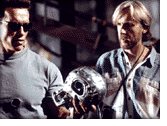 To
create the illusion of three dimensions, two cameras must simultaneously
film every sequence, already a demanding set-up. Further complicating
matters, T2/3D's show-stopping finale required interlocking 3-D
images across multiple screens, something that had never been
done before. Each of the three screens measures 23 feet high by
50 feet long, and when the movie fills the entire expanse, we're
talking about a 150-foot-wide panorama. To capture enough crisp
detail for such a grand presentation, the filmmakers chose to
shoot the action on high-resolution 65mm film stock, necessitating
the use of cameras approximately four times larger than standard
equipment. Rigging two of those cameras together created a brute
the size of a washing machine, weighing 450 pounds, and that bulky
contraption had to be highly mobile. Towards that end, an elaborate
pulley system was devised that allowed for sweeping camera moves
at speeds of up to 50 miles per hour. As Russell Carpenter, director
of live-action photography said, "We could literally fly
through explosions." To
create the illusion of three dimensions, two cameras must simultaneously
film every sequence, already a demanding set-up. Further complicating
matters, T2/3D's show-stopping finale required interlocking 3-D
images across multiple screens, something that had never been
done before. Each of the three screens measures 23 feet high by
50 feet long, and when the movie fills the entire expanse, we're
talking about a 150-foot-wide panorama. To capture enough crisp
detail for such a grand presentation, the filmmakers chose to
shoot the action on high-resolution 65mm film stock, necessitating
the use of cameras approximately four times larger than standard
equipment. Rigging two of those cameras together created a brute
the size of a washing machine, weighing 450 pounds, and that bulky
contraption had to be highly mobile. Towards that end, an elaborate
pulley system was devised that allowed for sweeping camera moves
at speeds of up to 50 miles per hour. As Russell Carpenter, director
of live-action photography said, "We could literally fly
through explosions."
And there
were explosions aplenty. Nighttime live-action segments were lensed
on a one-million-square-foot "set" around an abandoned
steel mine in California's Mojave desert. After scattering the
battered wreaks of more than 100 cars, trucks and buses throughout
the area, pyrotechnics teams went about blowing nearly everything
to smithereens. Four-story buildings, not scaled miniatures, were
reduced to flaming rubble.
Once principle
photography was completed, 47 Digital Domain CGI artists toiled
over high-powered computers, layering innumerable digital effects
over the footage.
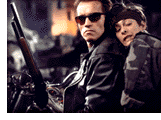 Meanwhile,
show producers were preparing T2/3D's non-cinematic ingredients.
Due to the technical complexity of the concepts Landmark and Cameron
cooperatively envisioned, a feasibility-study prototype of the
T2/3D show chamber was set up at a rented airplane hangar in Van
Nuys, California. Inside this top-secret facility, the attraction's
developers tested and retested the interaction between the in-theater
stunt performers, moving sets and props, and the projected images.
Before, during and after film production, live-action choreography
had to be honed to split-second perfection. Meanwhile,
show producers were preparing T2/3D's non-cinematic ingredients.
Due to the technical complexity of the concepts Landmark and Cameron
cooperatively envisioned, a feasibility-study prototype of the
T2/3D show chamber was set up at a rented airplane hangar in Van
Nuys, California. Inside this top-secret facility, the attraction's
developers tested and retested the interaction between the in-theater
stunt performers, moving sets and props, and the projected images.
Before, during and after film production, live-action choreography
had to be honed to split-second perfection.
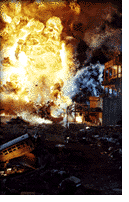 As
all the elements came together, technicians began assembling the
actual show chamber, packing it to the rafters with high-tech
gear: over 100 miles of cable that snake through the attraction
and connect the various audio, video and show control devices;
six animated eight-foot-tall T-70 "Cinebotic" Terminators,
driven by 3,000-pound-per-square-inch hydraulic pump systems;
a one-of-a-kind Harley Davidson "Fat Boy" motorcycle
that, along with its propulsion mechanism, tips the scale at 1,500
pounds. You think your home stereo equipment is impressive? The
T2/3D theater features a custom audio set-up that pumps 45,620
eardrum-pounding watts through 159 speakers. As
all the elements came together, technicians began assembling the
actual show chamber, packing it to the rafters with high-tech
gear: over 100 miles of cable that snake through the attraction
and connect the various audio, video and show control devices;
six animated eight-foot-tall T-70 "Cinebotic" Terminators,
driven by 3,000-pound-per-square-inch hydraulic pump systems;
a one-of-a-kind Harley Davidson "Fat Boy" motorcycle
that, along with its propulsion mechanism, tips the scale at 1,500
pounds. You think your home stereo equipment is impressive? The
T2/3D theater features a custom audio set-up that pumps 45,620
eardrum-pounding watts through 159 speakers.
It took literally
hundreds of specialists, months of work and over $60 million to
put it all together. But that effort paid off in spades.
.
. . . . . . . . . . . . . . . . . . . . . . .
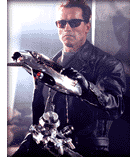 T2/3D
is not a standard dark ride, per se; the theater seats do pack
a few motion-based surprises, but there are no moving vehicles
to speak of. But as a fully-enclosed amusement park attraction,
this sucker is in a class by itself. During one show I saw, the
first major 3-D effect had a stranger on my left nearly throwing
himself over the arm rest and into my lap. It's that good. T2/3D
is not a standard dark ride, per se; the theater seats do pack
a few motion-based surprises, but there are no moving vehicles
to speak of. But as a fully-enclosed amusement park attraction,
this sucker is in a class by itself. During one show I saw, the
first major 3-D effect had a stranger on my left nearly throwing
himself over the arm rest and into my lap. It's that good.
We enter the
Cyberdyne headquarters for a splashy corporate presentation of
their latest technology. While waiting on line, overhead monitors
play a series of beautifully-produced videos illustrating some
of Cyberdyne's recent history, including the bizarre attacks of
a lone psychotic terrorist by the name of Sarah Connor. We also
get a couple of safety tips to observe while inside the facility.
I'll only say this: keep your hands off the pretty gadgets on
the walls; Cyberdyne is watching.
We pick up
"safety glasses" to wear once we're inside the main
theater, then we head into the theater lobby. There, we're greeted
by a perky, officious public relations executive who gives us
a taste of what we're about to see. She gets the ball rolling
with another slick corporate video presentation, a morbidly humorous
taste of the "better living through technology" that
Cyberdyne has planned for the world. Featured, of course, is SkyNet,
their new self-defense computer system, ready to go online. As
we already know, this is very bad news indeed. Suddenly, the video
signal goes funky - Sarah and her son, John Connor, have broken
into the facility and... well, here's where things really start
to happen.
We're quickly
ushered into the huge theater. Once we're seated, the PR lady
takes to the stage and proudly announces Cyberdyne's latest achievement:
the new Terminator-series T-70 combat robots. From with wings
rise six full size prototype Terminators, armed to the teeth.
We're instructed to put on those "safety glasses" and
in an ear-shattering racket, we watch a display of their prowess.
Their machine guns blast away at targets hanging on the walls,
sending real paper shards fluttering down over the audience. Do
they actually fire live rounds? Probably not, but I wouldn't stand
up to leave at this point.
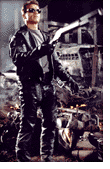 Sarah
and John Connor make their dramatic entrance, weapons drawn, and
start going at it with the Terminators. Running and jumping across
the stage, they manage to disable the 'bots. Looks like the coast
is clear... Sarah
and John Connor make their dramatic entrance, weapons drawn, and
start going at it with the Terminators. Running and jumping across
the stage, they manage to disable the 'bots. Looks like the coast
is clear...
But then that
big metal Cyberdyne logo hanging on the back wall of the theater
starts to change. Do the words "liquid metal" sound
familiar? (This is when that guy on my left began to freak out.)
Yes, folks, it's the T-1000, and he's comin' at ya! It's looking
grim for our heros. Suddenly, a mist-enshrouded time portal opens
in the center of the wall and our Terminator pal bursts through
astride his trademark "Fat Boy." He pilots the bike
down across the stage and scoops up John in the nick of time.
Narrowly escaping the T-1000, they ride back into the time portal
and back to the future. (By the way, if you were impressed by
the - yawn - flying chandelier sequence in Broadway's "Phantom
of the Opera," wait'll you get a load of that Fat Boy racing
all over the stage and then plowing back into the time portal.)
Now we're
fully in 3-D World and we're just getting started.
 John
and the Terminator hustle across the battle-scarred wasteland
that is Los Angeles, 2029, post-Judgment Day. The plan is to head
for SkyNet and take out the core, destroying it forever. They've
got the T-1000 on their tail, huge "Hunter-Killer" flying
gunships overhead, these new mini Hunter-Killers buzzing around
like aluminum death-gnats, and there's even another old-school
Terminator thrown in for good measure. Mix that all up and you've
got an action sequence that never slows down. Pulsing laser fire
and massive balls of flame explode before our eyes as in-theater
wind, smoke and light effects draw us right into the spectacle.
One particularly cool effect: as a Terminator gets "disassembled"
in a fiery cataclysm, we watch from above as its steel skull rises
towards us, crackling with electrical sparks in a final death
grimace. John
and the Terminator hustle across the battle-scarred wasteland
that is Los Angeles, 2029, post-Judgment Day. The plan is to head
for SkyNet and take out the core, destroying it forever. They've
got the T-1000 on their tail, huge "Hunter-Killer" flying
gunships overhead, these new mini Hunter-Killers buzzing around
like aluminum death-gnats, and there's even another old-school
Terminator thrown in for good measure. Mix that all up and you've
got an action sequence that never slows down. Pulsing laser fire
and massive balls of flame explode before our eyes as in-theater
wind, smoke and light effects draw us right into the spectacle.
One particularly cool effect: as a Terminator gets "disassembled"
in a fiery cataclysm, we watch from above as its steel skull rises
towards us, crackling with electrical sparks in a final death
grimace.
Against all
odds, they arrive at SkyNet, one scary-looking place. Once inside,
they hop on board an elevator to sink into the core. The side
walls of the theater rise and our seats rumble as we descend with
them. Now the image fills the three screens, practically wrapping
around the entire audience. You can feel the tremor of communal
excitement rippling everywhere.
Once they
reach the core, all they have to do is toss a little boom-boom
into the room and split. But SkyNet has something waiting for
them: the T-1,000,000.
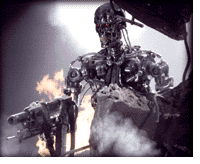 Ladies
and gentlemen, boys, and girls, you may never see a more effective
3-D sequence than the jaw-dropping climax you witness here. What
seems to be a 30-foot-tall static metal form slowly begins to
move. As our heros race to plant the explosives, the metal warps
into a monstrous, gleaming spider, bristling with dagger-sharp
appendages. When that roaring beast starts stomping around and
reaching off the screen, jabbing its spiky tentacles right towards
your eyes, I defy you not to lean away. At the last second, the
explosives detonate, our seats shudder and a billowing cloud of
smoke fills the theater. Ladies
and gentlemen, boys, and girls, you may never see a more effective
3-D sequence than the jaw-dropping climax you witness here. What
seems to be a 30-foot-tall static metal form slowly begins to
move. As our heros race to plant the explosives, the metal warps
into a monstrous, gleaming spider, bristling with dagger-sharp
appendages. When that roaring beast starts stomping around and
reaching off the screen, jabbing its spiky tentacles right towards
your eyes, I defy you not to lean away. At the last second, the
explosives detonate, our seats shudder and a billowing cloud of
smoke fills the theater.
It's beyond awesome.
I've had the
pleasure of experiencing T2: 3-D on many occasions and at the
end of every show, the audience clapped and cheered with unrestrainted
enthusiasm; standing ovations are not uncommon. The Hollywood
Studios property now has its own version of T2: 3-D, where it's
proven to be as just as popular, and Universal is installing a
third version at its park now under construction in Osaka, Japan.
.
. . . . . . . . . . . . . . . . . . . . . . .
And what could
be cooler than all this? Well, I'll tell ya: a fourth feature-length
Terminator film is in development.
To which I can only reply: "WE ARE NOT WORTHY! WE ARE NOT
WORTHY!"
All photos
on this page courtesy of Universal Studios, unless indicated otherwise
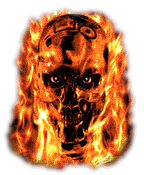
Top |